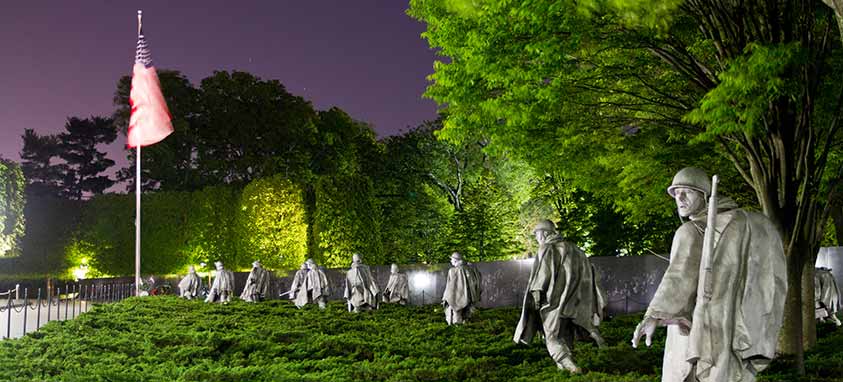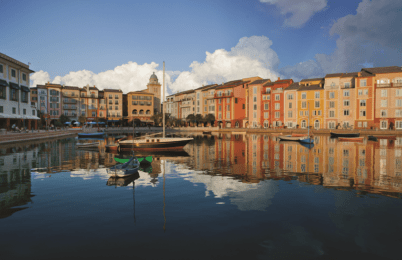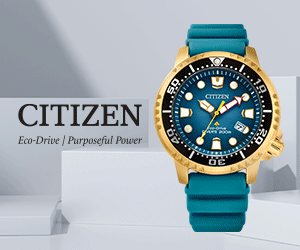Greater Washington, D.C., and Baltimore are designed for outstanding, unique adventures
Korean War Veterans Memorial
Washington, D.C., has always been a city about meetings. The nation’s capital was created after a meeting between Alexander Hamilton, Thomas Jefferson and James Madison, who proposed the Southern states (reluctantly) agree to allow the newly formed federal government to pay off all states’ Revolutionary War debts in return for locating the U.S. capital in the South.
At the time, representatives from New York City and Philadelphia were adamant the capital be located farther to the north. Thanks to that historic meeting, known as the Compromise of 1790, the Founders chose the swampy, mosquito-infested area renamed the District of Columbia, and the United States had its capital.

Washington, D.C.; George Washington Masonic National Memorial
President George Washington commissioned French architect Pierre Charles L’Enfant to draft plans for the new nation’s center of power. Designed to emulate Paris, Washington, D.C., was configured to accommodate wide-open public spaces through a series of rectangular blocks, pushing outward from the city’s center. L’Enfant’s grid pattern set the stage for the rise of spectacular monuments, art galleries and museums along today’s National Mall.
After more than two centuries, Washington, D.C. is arguably the nation’s most historically relevant, well-preserved, and aesthetically pleasing city. For professional event planners, the District of Columbia and surrounding area remains a grand place to hold meetings.
Alexandria
Founded in 1749, Alexandria, Virginia, is a must-see city for meeting-goers visiting Washington, D.C.
“If you love history, we’ve got that,” says Lorraine Lloyd, senior vice president of sales for Visit Alexandria, the city’s CVB. “We call ourselves D.C.’s original old town because we were part of D.C. years ago.”
Visitors can get there via public Metrorail or Metrobus, or in a water taxi. Metrorail takes you from downtown Washington, D.C., to the King Street Metro station in Old Town. For a more leisurely trip, take a paddleboat. The Potomac Riverboat Co. offers 30-minute rides from the capital’s National Mall area to Alexandria’s waterfront.
The rejuvenated waterfront has new parks, restaurants and Hotel Indigo Old Town Alexandria, which just opened. It’s the city’s first waterfront hotel and is perfect for VIP board and committee meetings.
“We really cater to the small, mid-sized meetings,” Lloyd says. “We tend to find out about the group—what they’re looking for. Is it budget-driven? A lot of groups want to experience the Old Town restaurants in the historic district.”
Leah Spellman, Visit Alexandria’s communications manager, says today’s Old Town “hums with more than 200 independent restaurants and boutiques, alongside intimate historic museums and a vibrant waterfront.”

Torpedo Factory Art Center, Alexandria, Virginia
History buffs should check out Alexandria’s museums, including Carlyle House Historic Park, Gadsby’s Tavern Museum, Stabler-Leadbeater Apothecary Museum, George Washington Masonic National Memorial and George Washington’s Mount Vernon Estate, 8 miles south of Old Town.
“Art enthusiasts love the internationally known Torpedo Factory Art Center,” Spellman says. “Alexandria is lively, welcoming, romantic, nostalgic and stylishly hip, against a historic backdrop.”
Spellman also recommends Old Town’s vibrant dining scene, filled with restaurants in historic buildings, pubs and live entertainment in the evenings.
More than 20 new restaurants opened last year, including Vola’s Dockside Grill & Hi-Tide Lounge on the waterfront. Other dining options include Virtue Feed & Grain, which Lloyd describes as “rustic chic.” Fish Market, a local hangout, is famous for fresh seafood, schooners of beer and shrimp tossed in a house-made seasoning. Hank’s Oyster Bar is another local favorite. Beer aficionados will enjoy tastings at Port City Brewing Co. and the new Portner Brewhouse.
“People are just in awe of Alexandria,” Lloyd says. “It’s a magical place—extraordinary.”

Crowne Plaza Old Town Alexandria
Fewer than 6 miles from Washington, D.C., and 2 miles from Ronald Reagan Washington National Airport; 254 guest rooms; fitness center; tennis courts; more than 10,000 sq. ft. of attractive event space and nine meeting rooms; banquet facility, focused on sustainability practices, accommodates 450 guests.
Hilton Alexandria Old Town
Recently renovated, including lobby, guest rooms, restaurant and meeting spaces; two blocks from King Street Metro station; 252 guest rooms; fitness center; 10,000 sq. ft. of function space, including 500-seat grand ballroom; outdoor courtyard area for up to 125.
The Westin Alexandria
Views of Old Town, historic monuments and Potomac River; Green Choice ensures water and energy conservation throughout venue; Trademark Restaurant offers business-casual dining; Workout Fitness Studio and New Balance sporting gear lending program; 319 guest rooms; 20,000 sq. ft. of event space.
Baltimore
Although Bethesda, Chevy Chase and Silver Spring often are associated with Washington, D.C.’s Beltway area, Baltimore remains the best-known city in Maryland. With its proximity to Baltimore-Washington International Thurgood Marshall Airport (BWI) and popular waterfront, Baltimore is a distinctive venue to conduct business meetings as well as a rewarding place to visit.
“The city is undergoing a renaissance that is creating amazing destinations from untapped industrial spaces all along our waterfront and downtown core, driving significant job growth, attracting millennials and enhancing Baltimore’s brand,” says Julia Watkins, public relations manager for Visit Baltimore, the city’s CVB.
At the center of this ongoing redevelopment is Baltimore Convention Center, located downtown near the city’s Inner Harbor and offering 421,000 sq. ft. of meeting and event space.

Baltimore Water Taxi at Inner Harbor
Although Baltimore is said to be one of the safest and most walkable cities in the United States, Watkins says if you prefer not to walk, Baltimore Water Taxi offers scenic trips across the harbor.
“You can also catch a ride on one of the Charm City Circulator buses to get around Baltimore,” she says.
For sightseeing, Baltimore is overflowing with options. Check out American Visionary Art Museum, one of the city’s quirkiest venues and home to original works of art created by self-taught artists.

Babe Ruth statute at Oriole Park at Camden Yards, Baltimore
Oriole Park at Camden Yards, considered one of the best stadiums in Major League Baseball, is accessible to most luxury hotels in Baltimore (see Major Meeting Venues on p. 111).
Consistently ranked among the nation’s top public aquariums, National Aquarium has attracted more than 51 million visitors since opening in 1981. It’s home to more than 20,000 fish, birds, amphibians, reptiles and marine mammals.

Fort McHenry, Baltimore
Fort McHenry, site of one of the key battles in the war of 1812, is also the birthplace of the National Anthem. “At Fort McHenry, you can find out what it was like to be one of the soldiers during the Battle of Baltimore,” Watkins says.
Other key Baltimore attractions are Baltimore Museum of Art, Frederick Douglass-Isaac Myers Maritime Park, Geppi’s Entertainment Museum, Maryland Historical Society, The National Great Blacks in Wax Museum, Reginald F. Lewis Museum, Star-Spangled Banner Flag House and The Walters Art Museum.
As for Baltimore’s culinary scene, Watkins says the city has transformed into a bona fide food-lovers’ destination. She recommends Phillips Seafood, where authentic Maryland crab cakes and classic steamed crabs are served; Pratt Street Ale House, the longest-running brewery in the city; and Wit & Wisdom, a traditional tavern with some of the best waterfront views in Baltimore.
Baltimore Marriott Inner Harbor at Camden Yards
Near Oriole Park, home of MLB’s Baltimore Orioles, and M&T Bank Stadium, home of the NFL’s Baltimore Ravens; dining includes Bricknfire Pizza Co. and The Yard; fitness center with cardio equipment; 500 guest rooms; 18,472 sq. ft. of event space and 25 meeting rooms.
Baltimore Marriott Waterfront
Located near Baltimore Aquarium and Camden Yards; eco-friendly practices; fitness center; indoor pool; dining includes Apropoe’s locally sourced, sustainable ingredients, and Fresh Bites American-style food; 750 guest rooms; 50,527 sq. ft. of event space.
Embassy Suites by Hilton Baltimore Inner Harbor
Near Camden Yards, National Aquarium and Johns Hopkins University; renovation to be completed August 15; B’More Bistro; 300 guest rooms; 45,000 sq. ft. of meeting space.

Four Seasons Hotel Baltimore
Overlooks Baltimore Inner Harbor, with views of city skyline; outdoor pool with stunning view of harbor; 10,200-square-foot spa; yoga classes; dining includes Wit & Wisdom: A Tavern by Michael Mina, and Splash Pool Bar & Grill; 257 guest rooms; 20,595 sq. ft. of event space.
Hilton Baltimore
Connected to Baltimore Convention Center; close to Camden Yards, National Aquarium and Maryland Science Center; indoor heated pools; Diamond Tavern, cocktail and coffee bars; 757 guest rooms; 110,000 sq. ft. of event space at convention center, accessible by sky bridge.
Holiday Inn Baltimore Inner Harbor
Situated close to Baltimore Convention Center, University of Maryland and Camden Yards; fitness center; indoor pool and sauna; dining options include Eden West Restaurant and Dottie’s Cafe; cocktail lounge; 365 guest rooms; 14,000 sq. ft. of event space, featuring 11 meeting and banquet rooms for 12 to 550.
Hyatt Regency Baltimore Inner Harbor
AAA Four Diamond hotel near museums, concert venues, Camden Yards and Maryland Zoo; Stayfit 24-hour gym; outdoor pool; dining includes Bistro 300 restaurant and lounge; 488 guest rooms; 35,000 sq. ft. of meeting and banquet space; 14,161-square-foot ballroom.
Kimpton Hotel Monaco Baltimore
Built in 1906 as B&O Railroad headquarters; AAA Four Diamond hotel; dining includes highly acclaimed, elegant B&O American Brasserie, featuring seasonal, local ingredients; 202 guest rooms; more than 10,000 sq. ft. of meeting space; three ballrooms.
Radisson Hotel Baltimore Downtown-Inner Harbor
Located near convention center, Camden Yards and National Aquarium; fitness center; rooftop outdoor seasonal pool; airport shuttle; 323 guest rooms; 18,500 sq. ft. of function space; five ballrooms can be combined to generate 9,165 sq. ft. of space.
Renaissance Baltimore Harborplace Hotel
Waterfront location connected to the Gallery Mall; close to convention center; dining includes Watertable restaurant, with locally sourced American cuisine; 586 guest rooms; 27,548 sq. ft. of event space, including 21 event rooms; 14,241-square-foot grand ballroom.
Washington, D.C.
With three airports servicing Washington, D.C., it is one of the most accessible international destinations for event planners. Although the capital city is relatively small, it’s also crowded. The best way to get around is on the Metro.
“Metro’s expansive network of tunnels and above-ground tracks connect all four quadrants of D.C. with suburban Virginia and Maryland,” says Melissa Riley, vice president of convention sales and services for Destination DC, the city’s CVB. “The system is a convenient and affordable way for visitors to get around the region, and bulk group passes are available for meeting attendees.”
Six Metro lines service Washington, D.C., with stops at the convention center, Union Station, Penn Quarter, Foggy Bottom, Federal Triangle, Dupont Circle and 12 other stations in the city. In addition, Metro lines bring passengers to Bethesda, College Park, Rockville and Silver Spring, Maryland. Service also extends to Alexandria, Arlington, Falls Church, Reston, Springfield and Vienna, Virginia.
The best reason to ride the Metro is to see all the fantastic museums, monuments, art galleries and other famous attractions in Washington, D.C.

Fox Court at The Baltimore Museum of Art
Before hopping on the Metro, the National Mall beckons. Weather permitting, sightseers should attempt a walk, starting at the Washington Monument and U.S. Capitol building, and extending to the Lincoln Memorial, along the Potomac River.

George Washington statue at U.S. Capitol Building dome interior, Washington, D.C.
Among other new openings, Riley recommends National Museum of African American History & Culture. She says the newest Smithsonian museum was “hugely anticipated and continues to be an incredible draw for visitors, who spend an average of six hours exploring the documentation of African-American life, community, history and culture.”

Smithsonian American Art Museum, Washington, D.C.
Other must-see Washington, D.C., attractions are Smithsonian National Museum of Natural History, United States Holocaust Memorial Museum, Smithsonian National Air and Space Museum, The Women’s Memorial, National Gallery of Art, Newseum, National Museum of the American Indian, Smithsonian American Art Museum, Hillwood Estate, Museum & Gardens, The National Archives Museum, National Museum of the U.S. Navy, and Arlington National Cemetery.
Washington, D.C., also generates a lot of buzz around its cuisine, which ranges from ethnic fare of almost every conceivable type to Midwestern chop houses, to Southern-style restaurants.
“The dining scene is packed with culinary talent and international cuisine,” Riley says. “Within a short walk from the Walter E. Washington Convention Center, attendees can access Shaw, downtown and Penn Quarter, areas of the city known for a variety of incredible restaurants and cuisines.”
Some local favorites include Kinship, a modern American restaurant; Metier, offering a seven-course French tasting-menu; Arroz, with a contemporary take on flavors from Southern Spain and Morocco; and RPM Italian, catering to groups of up to 350, and featuring fresh pastas and slow-roasted meats.
“People might know Washington, D.C., for its iconic monuments, museums and memorials,” Riley says, “but when they arrive in our city for the first time, they are often surprised by D.C.’s authenticity, diverse neighborhoods, and sense of community. The city has a world-class public transportation system. Visitors will find people from all backgrounds, and the city wants people to know that all visitors are welcome.”
Fairmont Washington, DC Georgetown
Adjacent to upscale Georgetown; outdoor garden courtyard; Balance Gym fitness center; indoor pool; dining includes Juniper Restaurant, featuring local, fresh ingredients; 415 guest rooms; 29,000 sq. ft. of event space.

Grand Hyatt Washington
In the coveted Penn Quarter near Capitol Hill; fitness center; indoor pool; Cabinet breakfast buffet, Cure Bar & Bistro, Starbucks; 897 guest rooms; 42,000 sq. ft. of event space.
JW Marriott Washington, DC
Short walk from the National Mall and close to the U.S. Capitol; fitness center; indoor pool and whirlpool; dining includes Avenue Grill and 1331 Lounge; Starbucks; 777 guest rooms; 37,032 sq. ft. of event space, including 15 meeting rooms; 13,680-square-foot grand ballroom.
Marriott Marquis Washington, DC
Adjacent to Walter E. Washington Convention Center; LEED Silver-certified; 1,175 guest rooms; 100,474 sq. ft. of event space, including 80 event rooms and 54 breakout rooms; 30,600-square-foot Marquis Ballroom; two additional 10,800-square-foot ballrooms.

Omni Shoreham Hotel
A capital landmark since 1930; situated on 11 acres, near National Zoo; heated resort pool; full-service spa; fitness center; bike rentals; dining includes Robert’s Restaurant and Marquee Bar and Lounge; 834 guest rooms; 100,000 sq. ft. of event space.
Renaissance Washington, DC Downtown Hotel
Located in Chinatown, in Penn Quarter between Capitol Hill and the White House; near convention center; fitness facility; Aura spa; three restaurants; 807 guest rooms; 65,964 sq. ft. of event space including 33 meeting rooms.
The Ritz-Carlton Washington, DC
Recently redesigned; in the heart of the capital; Equinox Sports Club; full-service spa; 300 guest rooms; 16,000 sq. ft. of meeting and event space; 10,500-square-foot ballroom.
Trump International Hotel Washington, DC
Located on Pennsylvania Avenue near White House in newly renovated Old Post Office building; full-service spa; dining includes BLT Prime by David Burke restaurant and Benjamin Bar & Lounge; 263 guest rooms; 38,000 sq. ft. of total event space; 13,200-square-foot Presidential Ballroom.
Washington Court Hotel District of Columbia
265 luxurious guest rooms, including 27 suites; Bistro 525 specializes in seasonally driven, Mid-Atlantic dining; 18,000 sq. ft. of meeting space, including 3,850-square-foot grand ballroom.
Washington Hilton
Four blocks from Dupont Circle Metro; pool; McClellan’s Sports Bar and The District Line Restaurant; TDL cocktail lounge; 1,070 guest rooms; 110,000 sq. ft. of indoor and outdoor event space.
Washington Marriott Wardman Park
Near federal agencies, shopping and Rock Creek Park; dining includes Stone’s Throw Restaurant and Bar, Woodley Park Pantry and Harry’s Pub; 1,048 guest rooms; 193,169 sq. ft. of event space.
Fairfax: Prime Meetings County

Across the Potomac River from Washington, D.C., is Fairfax County, Virginia—another prime locale for meetings and events in the region.
Fairfax, which enjoys the nation’s second-highest median income, has plenty of dining options, and shopping at Tysons Corner, known as the Rodeo Drive of the East Coast. Despite its prosperity, the county also boasts lower hotel rates, menu prices and taxes compared to nearby areas.
Smithsonian’s National Air and Space Museum Steven F. Udvar-Hazy Center, in Chantilly, is sister to its counterpart on the National Mall. The collection includes the Space Shuttle Discovery.
Meeting venues include Bechtel Conference Center in Reston, which offers more than 5,700 sq. ft. of space. George Mason University Center for the Arts in the city of Fairfax has a concert hall that seats up to 1,935 attendees.
Perhaps Fairfax County’s greatest appeal is its own vibrant heritage. Foremost is George Washington’s Mount Vernon, the most visited historical estate in America. Nearby is the distillery that housed Washington’s whiskey business. Groups can experience both, after hours, and at discounted prices.
Gunston Hall, completed in 1759, was home to George Mason, who wrote the Virginia Declaration of Rights on which the U.S. Bill of Rights was based. The Georgian facade and elegant interiors belie modern meeting facilities for up to 150 people.
Some 100 Fairfax County hotels total offer more than 18,000 hotel rooms.
Hyatt Regency Fairfax features 316 guest rooms and 14,000 sq. ft. of meeting space. An atrium lobby provides a dramatic setting for up to 400 guests.
Hilton Garden Inn Fairfax is 11 miles from Washington Dulles International Airport (IAD). It offers 149 guest rooms and 6,000 sq. ft. of meeting space.
Fairfax Marriott at Fair Oaks is located near George Mason University. It has 316 guest rooms with private balconies and ergonomic workstations, plus 8,000 sq. ft. of meeting space.
Located in the city of Fairfax, Comfort Inn University Center offers 205 guest rooms and meeting rooms totaling 2,000 sq. ft. of space.
Arlington: An Intriguing, Affordable Alternative

Many meeting groups visiting the Greater Washington, D.C., area have found that Arlington, Virginia, is an inexpensive place to stay, with daily hotel rates averaging 20 percent less than the capital’s downtown hotels. Most of the hotels are within 3 miles of downtown Washington, D.C. and are just minutes away by bridge and the Metro. Located directly across the Potomac River, Arlington also is just a few minutes away from the area’s major attractions.
Arlington isn’t just a convenient, affordable access point to the capital, though. As Stay Arlington (the website of Arlington Convention and Visitors Service) points out, it’s a vibrant city with eight unique “urban villages” (neighborhoods) that feature an intriguing mix of old and new architecture, five-star dining spots and casual eateries, as well as high-end shopping and funky boutiques.
The city also features some of the nation’s most significant historical spots, including Arlington National Cemetery, Marine Corps War Memorial (Iwo Jima Memorial), Air Force Memorial and The National 9/11 Pentagon Memorial.
Arlington’s most recent claim to fame, arguably, is its lively, unique art scene. Dubbed “a hotbed of cultural abandon” by The Washington Post, it attracts a wide variety of adventurous artists. The city is home to more than 55 art organizations and dozens of galleries, and hosts more than 1,500 arts events annually.
Leading meeting hotels in Arlington include Crystal Gateway Marriott, featuring 698 guest rooms and 37,975 sq. ft. of meeting space, divided among 28 rooms. The property also provides an interior corridor that connects to Crystal City Metro.
DoubleTree by Hilton Hotel Washington DC–Crystal City boasts 627 guest rooms and 34,000 sq. ft. of versatile meeting space, with monument views. A reimagined meeting and event space on the 14th floor—Windows over Washington Collection—offers stunning views of the Washington, D.C., skyline.
The Westin Crystal City, a newly refreshed hotel featuring the brand’s popular wellness offerings, has 220 guest rooms and 16,000 sq. ft. of meeting space, spread across the first and second floors.




